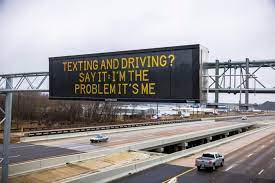Airline passengers are used to seeing those funny safety videos before they take-off, memorable clips of penguins tightening their seatbelts or diving for oxygen masks. But If you are traveling by car, you are going to be seeing more messages that tell you to buckle up, and fewer messages that are going to make you smile when you do that.
Beginning in 2026, highway administrators must curb the funny messages on their changeable message signs. The Federal Highway Administration (FWHA) is cracking down on what can, and cannot be said on those pixelated overhead electronic signs. More standard highway advisories will replace the funny sayings, obscure meanings, and pop jokes. If you are driving in Arizona, for example, messaging in 2026 might advise you to “drive alert, not distracted”– replacing a current sign that reads, “hands on wheel, not your meal.” (That said, a driver occupied with her phone might miss either message).
The motivation behind the FHWA decree is that funny signs can be misunderstood or distracting to drivers. Changeable message signs have been in use since the 1950’s, but over the years, state highway departments have gotten more liberal and creative in their use. Some DOT’s even run public contests to engage the public in wording funny messages.
Smiles Ahead:
Proponents of the humorous message sign disagree and say that they bring both bring a smile to drivers and are effective in conveying road conditions. They also localize the experience. For example, changeable message signs in Massachusetts poke at the local accent so drivers should “use yah blinkah”. Other favorites, but soon to disappear, are: “Hocus pocus, drive with focus” from New Jersey and “Visiting in-laws? Slow down, get there late,” from Ohio. Perhaps one that will sung long after comes from the Mississippi Department of Transportation. They posted a Taylor Swift themed message about texting and driving.: “say It: I’m the problem, it’s me.”

Like most things done in transportation, the FHWA decree is based on considerable research and study. However, in this case the data, like the messaging, is two-sided. Researchers at Virginia Tech tested undergrads with MRI scanning to detect how the brain interprets the highway signs. They did hundreds of simulations, and reported that the humorous messages did no harm. A Texas study, on the other hand, found 4.5% more traffic accidents over the next 6 miles after drivers read overhead signs. But the messaging on the Texas signs was very specific. It enumerated the number of road fatalities and cajoled drivers to slow down so that they did not become one.
Persuasion 101:
Outside of the transportation field there is evidence that ‘telling it straight’ is not the most persuasive solution. For example, studies to change smoking behavior learned that the messaging was more effective when it downplayed the risk of dying. Instead, it was best to highlight improvements in personal image. Likewise, in marketing, think SuperBowl ads, humor is effective because it activates a pathway in the brain that makes people feel happier. Then the message becomes something that is more likely to be talked about, shared and remembered. In other situations, like health care, humorous messaging is used to help clients reduce pain, relax and feel less stress- all issues that might be pertinent for drivers.
The final word on messaging work is that we do not all read the same thing. Every study will note that there are individual differences, say in the speed at which people read while driving, the native language they read in, and their familiarity with pop-culture and insider jokes. So, reverting to a traffic standard will be the safest course and bring the most uncontested results.
We should always drive with CARE, or was that with CAKE?

